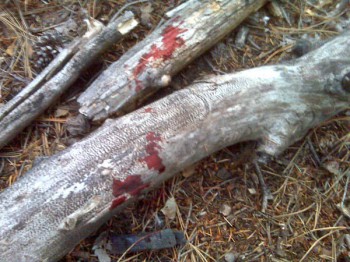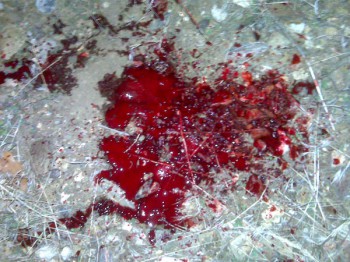 by Woody Williams
by Woody Williams
Less than a minute has elapsed since you’ve shot one of the biggest bucks you have ever seen. It happened so fast it’s hard to believe. What you do now may determine whether or not you’ll recover your buck.
Your first impulse is to bail out of your treestand and take off after him. Depending upon your arrow placement, this could be a big mistake. If a deer is not hit well you could spook him and make recovery next to impossible.Knowing where the animal is hit makes a difference in how you track him. For this reason, a bowhunter should use brightly colored fletching, such as orange or red.
The chest of the deer contains the lungs and the heart which, when hit, produce the quickest kill. The lungs are easily reached by an arrow, protected only by vulnerable rib bones. The heart is low in the body and somewhat protected by the deer’s leg bone.
The following describes types of hits and how you should track for each.
* A lung-shot deer will run hard 50 to 65 yards. After that he will usually walk until he falls. The blood will sometimes have tiny bubbles in it. This blood trail usually gets better as you track the deer. However, if the deer is hit high in the lungs, the blood trail may sometimes become light and even disappear completely. The deer could be “filling up” inside with blood, showing very little external bleeding. The hair from the lung area is coarse and brown with black tips. The deer will usually go down in less than 125 yards. Give the deer 30 minutes before tracking.
* A heart-shot deer will sometimes jump wildly when hit. The blood trail may be sparse for the first 20 yards or so. A heart shot deer may track as much as a quarter of a mile, depending on what part of the heart is damaged. The usual is less than 125 yards. The hair from this shot will be long brown or grayish guard hairs. Again, a 30 minute wait is advised. But, if while trailing you find where he has bedded back off and wait an hour before taking up the trail again.
* A liver-shot deer. The liver lies against the diaphragm in the approximate center of the deer. It is a definite killing shot. The blood trail will be decent to follow and the deer should bed down and die within 200 yards, if not pushed. A one-hour wait is best. The hair from the liver area is brownish gray and much shorter than the hair from the lung area. If you push the deer out of his bed, back off and wait another hour.
* A gut-shot deer is probably the most difficult to recover because of the poor blood trail and the hunter’s impatience to wait him out. A lot of bowhunters want to hurry up and find the deer. Since the liver and stomach are close together, it is possible that the deer will go down and die quickly if the shot also penetrates the liver. If the deer is dead in an hour, he will still be dead in 4 hours. Have patience, he will not go anywhere. Wait him out for at least 4 hours. Wait overnight if the deer is shot in the evening. When a deer is shot in the stomach area, he will usually take several short jumps and commence walking or running. His back will usually hunch up and his legs will be spread wide. The hair from this wound is brownish gray and short. The lower the shot is on the animal, the lighter colored the hair will be. The blood trail is usually poor with small pieces of ingested material (stomach contents). If the intestines are punctured there will be green slimy material or feces Take your bow with you because a second shot might be required.
* A spine-shot deer will usually drop in his tracks or hobble off. Either way, a second shot will probably be required to finish off the deer. If a spine-shot deer hobbles off, wait a half-hour and track slowly and quietly. Look for the deer bedded down.
* A neck-shot deer will either die in 100 yards or he will recover from the wound. The lower portion of the neck contains the windpipe, neck bone (spine), and carotid (jugular) arteries. If the arteries are hit, the deer will run hard and drop in less than 100 yards. The blood trail will be easy to follow. A shot above the neck bone will give you a good blood trail for about 150 to 200 yards before quitting. The deer will more than likely recover to be hunted again.
* A hip-shot deer. A large artery (femoral) runs down the inside of each deer leg. This artery is protected from the side by the leg bones. The femoral artery is most often severed from the rear or at an angle. If this artery is cut, the bleeding will be profuse and the deer will usually be found in less than 100 yards. The ham of a deer is also rich in veins with a lot of blood. A hip-shot deer should be tracked immediately. Track him slowly and quietly to keep him moving (walking). If you jump him and he runs, back off for a few minutes then continue trailing. You want him to walk, not run. A walking deer is easier to trail.
* An artery-shot deer will almost always go down in less than 100 yards. The aortic artery runs just under the backbone from heart to hips, where it branches to become the femoral arteries. The heart also pumps blood to the brain through the carotid (jugular) arteries. Sever any of these arteries and you’ve got yourself a deer. There is one catch, these arteries are tough. It takes a sharp broadhead to cut through them. A dull broadhead will just push them aside. Keep your broadheads sharp! Give the deer half an hour before tracking.
 GENERAL TRACKING TIPS
GENERAL TRACKING TIPS
* After shooting the deer, stay in your stand and be quiet for the recommended time. A noise might push your deer away. He could be bedded down less than 100 yards away.
* I have found it very helpful to tie a piece of pink surveyor ribbon around my stand tree at eye level from where I shot. After noting several terrain features near where the deer was standing and where it ran too, I tie on the ribbon before coming down. From the ground looking back up to the ribbon, I can get a better visual for locating exactly where the deer was and went.
* Before beginning the tracking, mark where you shot the deer with a piece of white toilet paper hung on a branch.
* Mark the trail periodically with more toilet paper as you track. This will give you a line on the deer’s travel.
* When you find the arrow, check for hair, tallow, blood, etc. This will give you a good clue on how to track. Example: Tallow and slime means you should wait 4 hours.
* Check for blood carefully, walking off to the side of the run.
* Look for blood on trees, saplings, and leaves that are about the same height as the wound. Blood will sometimes rub off the body.
* If tracking as a group, spread out a little. Keep noise to a minimum. In tracking, sometimes “too many cooks can spoil the stew.” It would be better if only 2 or 3 people tracked the deer. If the blood trail runs out, you can always get more help to search for the deer.
* While tracking a deer that you have shot and you jump a deer and it flags its tail, it’s probably not your deer. A wounded deer will very seldom “flag.” BUT – check it out anyway.
* Gut-shot deer have a habit of going to water. If you lose a gut-shot deer’s trail, check out the water holes in the area. He could be down by one.
* Tracking at night presents special problems with visibility. The blood and the deer will both be hard to see. A Coleman gas lantern will help a lot in both cases. If the deer is not hit well, and no rain is forecast, wait until morning. If he is dead in 10 minutes or 4 hours, he will still be dead in the morning.
* Take a compass bearing to where you last saw the deer, and another one to where you last heard any noise from it’s flight. It might prove very helpful.
* It helps to have someone who did not shoot the deer to help with the blood trial. Many an experienced hunter in his excitement misses things.
* Stay off of the blood trail, and use a small piece of tolled paper to mark each spot
* Get down on your hands and knees when a blood trail is hard to see it helps. From this angle while night tracking you can shine the light in the direction of travel and often see blood that does not show when standing over it.
* Look at the bottom of leaves on branches at deer body height. Sometimes as the branch slides along the body of a deer it is the under side of the leaf that picks up the blood.
* You will often find a gut shot deer or liver shot deer dead in the water not just beside it. so look for an ear or the side of the deer in deeper water too.
* Some shots that look good may be one lung or a poor liver hit because of the angle. These deer can take several hours to die. Be careful about pushing them to soon, since they will rarely leave much blood sign if they are jumped when bedded.
* Look ahead as you blood trail for deer parts and movement. Your deer may still be alive and you might be able to get a second shot or back off with out spooking it.
* Look for disturbed leaves and broken twigs as well as for the blood sign on hard to follow blood trails.
* It is often hard to follow a blood trail in grass. It seems that the blood can fall all the way to the ground without hitting a single blade of grass.
* Look for clusters of ants, flies and daddy longlegs. You can find small drops of blood because these bugs are feeding on it.
* Often times when the blood trail seems to end you will find the animal off to one side and not in the same direction of travel.
* Listen for birds like magpies, jays, and crows. Sometimes they make a ruckus where the animal lies dead.
* Be persistent!
* A dog can often prove very useful if legal. Even your house pet. They can see with their nose what we can not see with our eyes.
* Use your nose. sometimes you can smell a deer you can’t see. A gut shot is even more likely to have a smell.
* When trailing at night use a couple of the Chem Lights that you can get at WalMart for less than a buck. You don’t use these as lights to see blood, but they are hung on limbs at the last blood found. That way nobody has to stand on the last blood and everyone can easily see where the last blood found is at.
*print off a copy of this HOW-TO (put it in your pack and read over it during your wait).



Very helpful! Lots of good info!